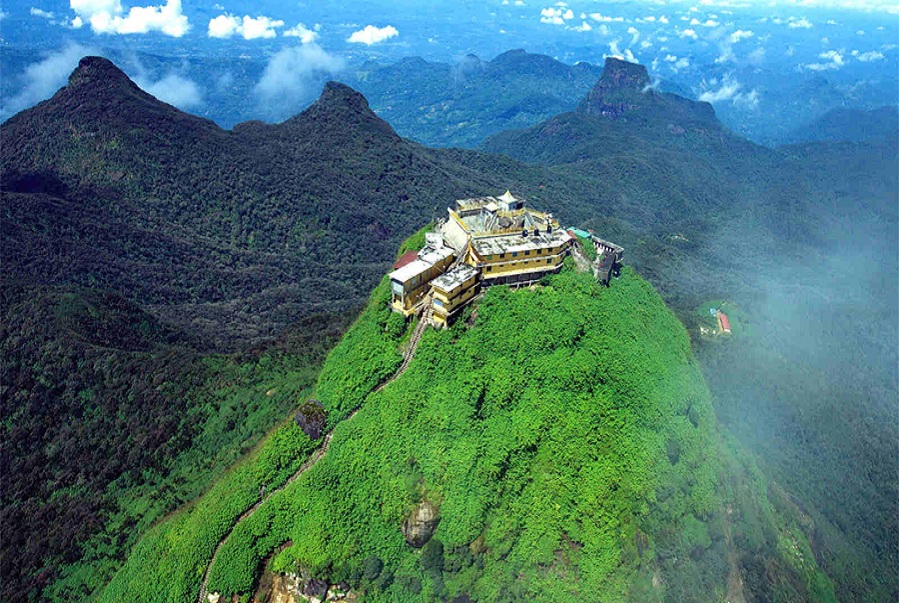From crimson to gold – beginning from the crack of dawn, and all the way up to sunrise, the sky changes colors every minute when you are at the summit of Adam’s Peak – Sri Lanka. And those few seconds where the sun is bringing itself out, you can literally see the golden ball of fire MOVING right before your eyes.
This is undoubtedly THE most beautiful sunrise in all of Asia. If you want to experience it, you will surely have to sweat it out to get there.
Getting There…
- Dalhousie of Nallathanniya is the base town for Adam’s Peak. Several guesthouses, restaurants and shops selling essential items are available here.
- You can reach Dalhousie by a direct bus from Colombo or Kandy if you are travelling during December – May (peak season). During off season, you have to get to get into three buses – with a stop at Hatton, Maskeliya and then Dalhousie.
- Private transport offered by all tour agents in Sri Lanka is the best option for pickup from your doorstep and drop right at the base of Adam’s Peak.
- Slightly Chilled and Hotel White Elephant are two recommended guesthouses if you want to stop over for a night after your tiring climb.
- There is absolutely no entrance fee in climbing the Adam’s Peak. You might run into some monks at the entrance who will tie a string around your wrist and request for a donation – but it is totally up to you.
The Climb…
- Climbing up the 5500 steps and then climbing down those very same steps is a murder for your calves and thighs. So be prepared for the challenge.
- Ideal time to begin for those who are on average fitness levels would be between 1.00 to 2.00a.m. This will leave plenty of time to climb the last stretch and be at the summit just in time for sunrise.
- Shoes are a must-have footwear. It doesn’t necessarily have to be hiking shoes but any kind of sports shoes with a good grip will suffice. If you have week knees, trekking poles are advised.
- Beginning the hike too early might lead to reaching the summit way before sunrise and then you would have to wait too long in the cold weather.
- In your backpack, be sure to carry a jacket, plenty of water and a headlamp (if climbing during the off season).
- At the base, you will see a trail of sparkling lights ascending into the sky until they become similar to the twinkling starts. Assure yourself that this is the night you will reach that last light on the mountain.
- The first half of the climb is quite easy with long walks and nicely carved out steps that are not so steep. The latter half gets narrower and steeper.
- On the way to the summit, there are small shops at regular intervals selling roti, hot tea and water; most of which are open only during the season time.
- Don’t be surprised if you come across local pilgrims chanting away in groups and climbing with bare feet – it is part of their pilgrimage.
- Choose a Sunday night rather than Friday or Saturday night (during peak season) if you want to avoid the crowds (especially at the summit) and have a peaceful climb.
The Summit… The View…
- The panoramic view at the summit of Adam’s Peak is one of the grandest in the world as there is no other mountain that present unobstructed views of land and sea as this one.
- The best view for sunrise is just a few feet before the peak itself: there is a small platform to the left of the stairs (if you are facing the peak).
- After sunrise, the view across the lakes, all the way to the Horton Plains and into the heart of Sri Lanka’s hill country is spectacular.
- Notice the shadow of the entire mountain fall behind you and imagine yourself at the peak of that mountain shadow.
- At sunrise, a small Buddhist ceremony takes place at the shrine where the footprint is treasured. Pilgrims then line up to enter the shrine and get a glimpse of the footprint.
- Some of the beautiful things to be observed on your way back in the daylight are some carved motifs, viewpoints displaying stunning waterfalls, a Japanese peace pagoda, a wilderness sanctuary, a hydropower project and the Baghava Cave (with inscriptions).
Every so often during your daylight descent, simply stop and enjoy the breathtaking view of the surrounding natural beauty.

